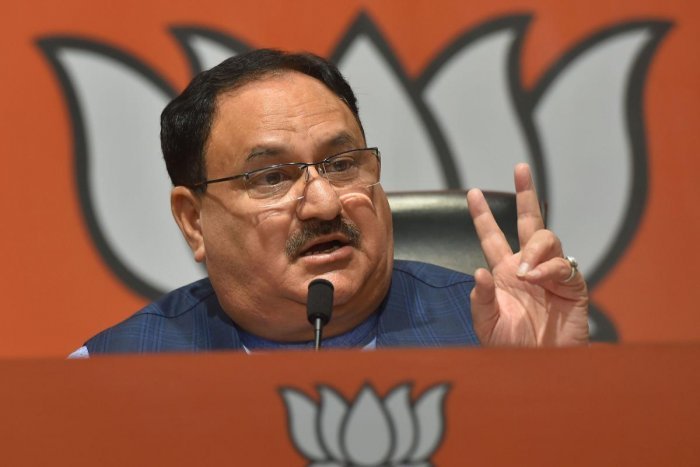
Prior to Narendra Modi’s rise within the Bharatiya Janata Party, not many outside the state of Himachal Pradesh knew who J.P. Nadda was. His tenure because the Union health minister during Modi’s first term can hardly be called eventful.
The only prominent announcement to return out of his ministry was the Ayushman Bharat Yojana, a federal insurance policy for the poor that his ministry oversaw. However, because the prime minister himself hogged all the limelight for the much-touted scheme, Nadda was forced out of the general public glare.
When the demure, soft-spoken and media-shy Nadda took over the reins of the BJP because the “working president”, soon after the newly-anointed Union home minister Amit Shah relinquished his position – as a part of the saffron party’s ‘one person, one post’ doctrine – in June 2019, party insiders felt that the so-called regime change was bare of any significance.
Nadda isn’t considered a match for Shah in the least . With Shah’s aggressive and action-packed stint of nearly six years because the precedent, most political observers feel that Nadda’s current reputation because the most trusted lieutenant of the Modi-Shah duo, quite the other qualitative aspect, earned him the coveted position that at a special time and age would have befitted a number of BJP heavyweights.
A transformed BJP
On Monday, Jagat Prakash Nadda finally got obviate that odd prefix “working” and was elected because the official full-time president of the BJP, unopposed. He joined the line-up of Sangh Parivar’s top leaders like Atal Bihari Vajpayee, L.K. Advani, Murli Manohar Joshi, Kushabhau Thakre et al. .
Yet, Nadda is probably going to stay within the shadows of the dominant Modi-Shah duo within the days to return . As working president, Nadda addressed BJP workers across the country quite frequently, inaugurated multiple events, worked behind the scenes to expand and organize the party, and braved electoral reverses in Jharkhand, Maharashtra, and Haryana. But he still managed to evade scrutiny, with the domineering presence of Shah around.
In fact, BJP’s transformation as a well-oiled, highly centralized machinery under the leadership of Modi and Shah has somewhat belittled the occasion of Nadda’s official appointment because the sole party president.
Under the duo’s leadership, the saffron party has consistently chosen to reward low-profile, conformist leaders, and sideline leaders with their own individual steam. as an example , Vijay Rupani was selected to steer the Gujarat government rather than the more popular, feisty Saurabh Patel. Similarly, the elevations of lesser-known state leaders like Raghubar Das, Devendra Fadnavis or Manohar Lal Khattar to the chief ministers’ positions signal an identical pattern.
At an equivalent time, state-level stalwarts of the party like Shivraj Singh Chouhan, Vasundhara Raje Scindia or Raman Singh not feature within the BJP’s list of prominent leaders, whilst senior leaders like Rajnath Singh or Nitin Gadkari – both former party presidents – remain contained within their respective ministries.
So much has been Modi-Shah’s dominance both in party and government, that the skinny line between the 2 has never been this blurred.
Within this political scheme, Nadda fits the BJP’s idea of representation, however, tokenistic one may argue it’s , very well. The party turned the socially-inclusive appointments of Ram Nath Kovind, a Dalit, as president of India and OBC leader Venkaiah Naidu because the vice-president of the country, along side Modi’s own backward class identity, into a decisive electoral advantage.
Nadda, a Brahmin leader, because the president of BJP is that the new element within the same representational matrix – an assurance to its core voter base that the party hasn’t entirely moved faraway from its traditional upper-caste characteristics.
Nadda’s journey through the party
In his first speech as president, Nadda spoke about how the BJP is that the only party during which a commoner like him from Himachal Pradesh could rise through the ranks to the highest . However, those conversant in BJP’s functioning would know that there’s a qualitative difference between his appointment which of his predecessors.
Given the present state of affairs within the party, the reserved Nadda was tactical enough to show his disadvantage into a blessing. He has actually risen through the ranks within the BJP due to his extraordinary consistency in remaining out of the general public view.
Nadda, now 59, was born in Bihar where he studied until college. At Patna University, he associated himself with the Akhil Bharatiya Vidyarthi Parishad, the students’ wing of Rashtriya Swayamsevak Sangh. He gained prominence within the anti-corruption JP movement and was elected as secretary of the students’ union within the 1977 polls.
After having decided to shift his base to his home state, he went on to steer the students’ union of the Himachal Pradesh University as a student , after having defeated the Communist Party of India (Marxist)-backed Students Federation of India (SFI) for the primary time in 1984.
He held leadership positions within the ABVP and Bharatiya Janata Yuva Morcha until 1993, when as a 33-year-old he first contested and won assembly elections in Himachal Pradesh. He repeated his wins within the Bilaspur constituency in 1998 and 2007, and held ministries in two BJP governments within the state.
Gradually, he emerged because the prime contender of chief minister Prem Kumar Dhumal; however, in 2010 Nadda resigned as a minister over differences with the chief minister.
His national innings started when then BJP president Nitin Gadkari brought him to New Delhi first because the national general secretary of the party then getting him elected as a Rajya Sabha MP in 2012. Since then, he has worked his high to Modi-Shah’s good books. it’s said that he played a crucial role in BJP’s huge electoral successes in Uttar Pradesh within the 2014 and 2019 parliamentary polls.
At the organizational level, his growth has been astounding; however, an equivalent can’t be said about his ministerial stints. He replaced Harsh Vardhan because the cabinet minister for health and family welfare in 2014 and continued therein role until 2019.
A tainted record
While his tenure was largely lackluster, it wasn’t freed from blemishes.
Nadda was accused of covering up multiple corruption scams worth Rs 7,000 crore within the All India Institute of Medical Sciences (AIIMS) during his stint because the health minister. the foremost notable controversy was when media reports claimed that Nadda attempted to hush up the Central Bureau of Investigation investigation into a Rs 3,700 crore corruption scam associated with engineering tenders at AIIMS.
Opposition parties, especially the Aam Aadmi Party, accused him of protecting the prime accused Vineet Chaudhary, the then AIIMS deputy director who as a Himachal Pradesh cadre IAS officer had worked closely with Nadda.
Nadda had reportedly written several letters between May 2013 to June 2014 to his predecessor within the health ministry to drop cases against Chaudhary. He also wanted the removal of Indian Forest Service officer Sanjiv Chaturvedi, who because the then chief vigilance officer of AIIMS, blew the whistle on a minimum of 200 corruption cases during his deputation at AIIMS since 2012.
Chaturvedi had by then earned a reputation of being brutally honest – something that the health ministry acknowledged repeatedly in his appraisal reports. Yet, soon after Modi came to power, Chaturvedi was relieved from his role because the CVO, AIIMS in August 2014, although he continued to be at AIIMS.
Later, when Nadda replaced Harsh Vardhan, he allegedly not only tried to hide up the case against Chaudhary but also multiple other such corruption scams exposed by Chaturvedi – one among them being a scam associated with purchase of medical paraphernalia during which the then AIIMS director M.C. Mishra was the first accused.
When Nadda became the health minister in November 2014, he attempted to reevaluate Chaturvedi’s appraisal report, which had described his performance as “outstanding”. When challenged by Chaturvedi, the Central Administrative Tribunal prevented Nadda from doing any such thing.
A year later, Nadda’s ministry was slammed by the parliamentary committee for not taking any action against corruption scams at AIIMS. By December 2015, however, the health ministry stripped all tasks assigned to Chaturvedi without mentioning any specific reason, although he was being paid a full salary. Meanwhile, all investigations within the corruption cases exposed by him were also canned.
Nadda’s elevation because the party president indicates that Modi and Shah are willing to oversee such a tainted diary during a leader, as long as they prove themselves to be committed foot soldiers in their scheme of expansion.
The new BJP party president ticks those boxes well. Rajan Pandey, an election analyst who has extensively toured Himachal Pradesh, had a stimulating anecdote to share. “For an extended time, Dhumal’s son and also Nadda’s rival Anurag Thakur was lobbying with the Centre to urge an AIIMS facility in Hamirpur, his seat. However, Nadda swiftly got the Modi government to open the power at Bilaspur, his old assembly constituency. This deepened the rift between the 2 leaders. Many thought that it could affect BJP’s prospects within the state.”
“But Nadda not only openly supported Thakur’s candidature within the Lok Sabha polls but campaigned extensively for him. He even got those MLAs who are seen on his side to campaign for Thakur,” Pandey said.
Nadda’s understated organizational skills have finally helped him land the highest post, while Thakur, who has never hesitated to point out his ambitious side, has apparently been sidelined. With the Delhi assembly elections lurking round the corner and Bihar assembly elections up later this year, Nadda has his task cut out. Yet, the road ahead for Nadda might not be as easy because it had been for him within the party so far .
This artical taken refrence from thewire


















